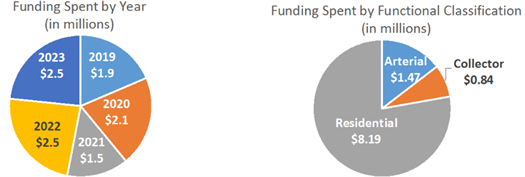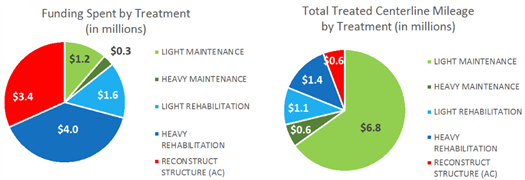by
City of Belmont
| Jan 17, 2019
Source: City of Belmont
The City is responsible for the operation, repair and maintenance of approximately 70 centerline miles (140 travel lane miles) of streets with a pavement replacement value of over $227 million in present day (2018) dollars.
In November 2016, Belmont voters approved the Belmont Streets and City Services Measure (Measure I), a half-cent general tax that will generate approximately $1.3 million annually for local infrastructure. The City Council has allocated $1M per year towards street pavement beginning with Fiscal Year 2018.
Furthermore, on April 28, 2017, the Governor signed Senate Bill (SB) 1, which is funded by the newly established Road Maintenance and Rehabilitation Account (RMRA), which receives four sources of new revenue to address basic road maintenance, rehabilitation and critical safety needs on both the state highways and local streets and road system. RMRA sources of funds are increases to the per gallon, fuel excise taxes; diesel fuel sales taxes, and vehicle registration fees; and it provides for inflationary adjustments to tax rates in future years. City anticipates receiving $160K in Fiscal Year 2018 and approximately $600k-700K in future years as a result of this funding.
The first project to be funded with Measure I and SBI funds is the 2018 Slurry Seal Project. This project will slurry seal approximately seven (7) centerline miles of streets and will be in construction during the summer of 2018.
Five Year Paving Program (2019-2023)
Given the passage of both Measure I and SB 1, these new funding sources provide an annual funding estimate of about $1.6 to $1.7 million for pavement maintenance, which equates to a funding estimate of $8.5M million over the next 5 years. In addition, the City Council has allocated $2M in Infrastructure funds to further assist the program, for a total of $10.5M over the next 5 years.
The 5 year program is based on the following guidelines:
- Utilize the City’s pavement management program, StreetSaver, as a platform to find the most cost-effective way in treating City streets.
- Include an assortment of streets by functional classification.
- Consider a concentration on arterials due to the heavy usage.
- Ensure that roadway treatments were spread around the City.
- Aggregate streets by recommended treatment plan for continuous construction and to minimize disruptions to residents and traffic.
- Allocate treatments to residential/collector streets that would not be chosen by StreetSaver, but serve commercial/business area, schools and safe routes to school, and including residential streets with history of complaints and maintenance issues.
- Minimize amount of streets on list that has received recent treatments.
The draft list may not fit the philosophy perfectly but is considered as the most cost-effective while staff continues to programmatically address the pavement needs, utility and development conflicts, and other roadway conflicts in the next five years. or streets planned in the 5-year program will need to be deferred due to utility conflicts, engineering consideration, cost of rehabilitation, etc. Streets on the list may also need additional work due to drainage problems, addition of sidewalks or ramps, or hillside slippage areas needing remedial work. Accordingly, those projects can be pushed down and/or switched with another proposed street on the optional list.
Funding is aimed to be distributed evenly throughout the five-year period, at approximately $2.1 million per year, as shown in the charts below.

Project Funding by Year, and Project Funding by Functional Classification.
Following the 2018 Slurry Seal Project, surface seal projects (light and heavy maintenance), mill and overlay projects (light rehabilitation), and surface reconstruction/reconstruction (heavy rehabilitation and reconstruction) is anticipated in the upcoming years. The figures below depict the cost effectiveness and importance of applying preventative maintenance treatments to preserve the City’s streets while in fair or good condition as the cost to heavy rehabilitation of one street segment is equivalent to light maintenance of 16 streets.

Funding Amounts by Treatment Type, and Total Mileage by Treatment Type.
The proposed $10.5 million in funding falls short of what is needed to bring all streets into good condition, but the overall network will improve to a PCI of 61while moving some of the Poor and Very Poor streets into a Good condition.
This plans provides the department with a road map to allocate its resources to address community’s need for improved infrastructure. However, it should be noted that the proposed five year plan is a planning level document, and may be subject to refinement to maximize cost-effectiveness based on number of factors including utility conflicts, unplanned maintenance projects, other capital projects and development project coordination, and escalation in construction costs. As part of the Annual CIP Budget presentation staff will provide the Council with the updated list of streets on an on-going basis as each year’s project scopes are better defined based on technical and funding availability.
Source: City of Belmont